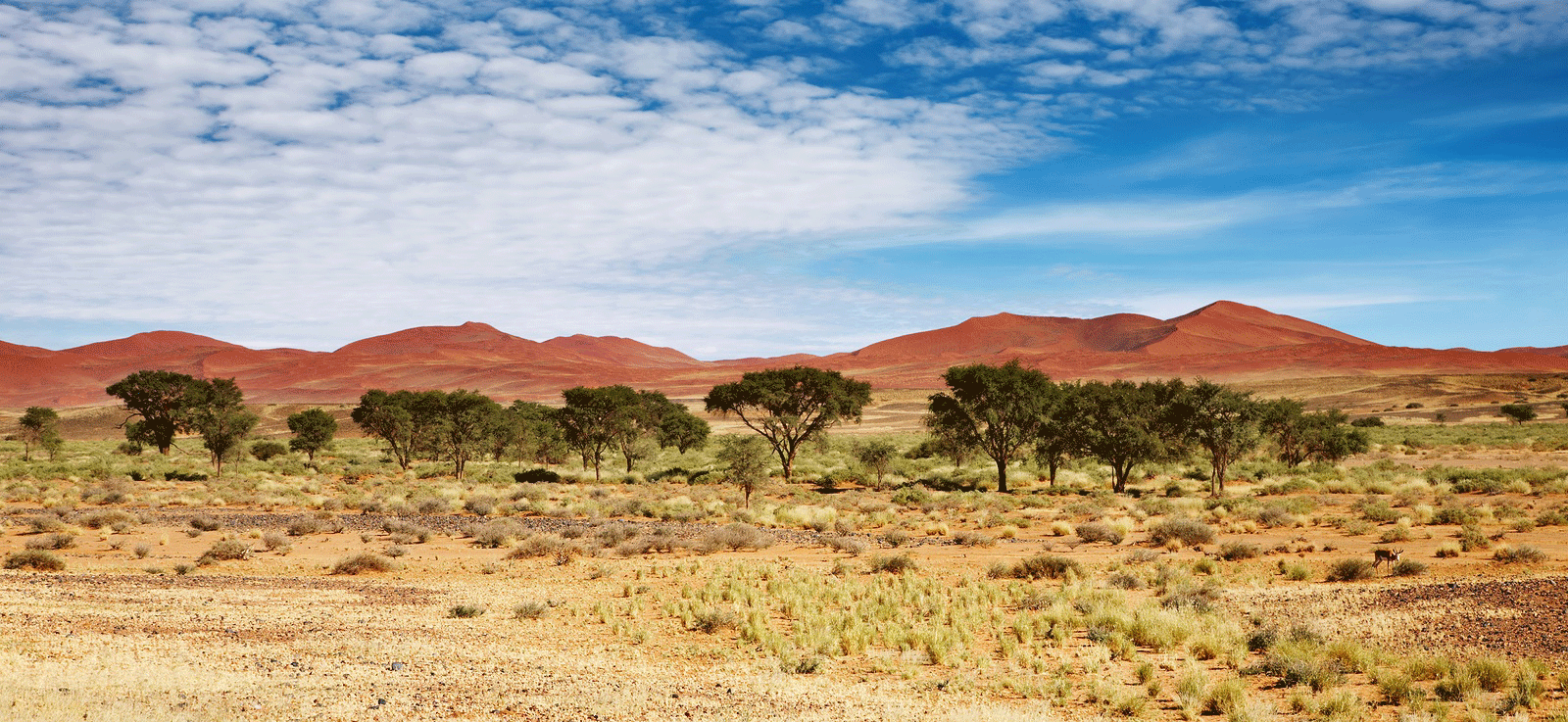November 16, 2012
Air Date: November 16, 2012
FULL SHOW
SEGMENTS
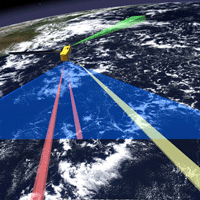
The Best Climate Projections Are Extreme
View the page for this story
Scientists agree that the planet is warming, but there is a wide range of projections as to how hot it’s going to get. A new analysis from scientists at the National Center for Atmospheric Research finds that the more alarming estimates may be the most accurate. John Fasullo, one of the climate scientists responsible for the analysis, joins host Steve Curwood to discuss the future of our warming planet. (06:20)
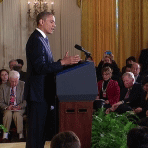
President Obama Speaks Out on Climate Action
View the page for this story
President Obama says he believes in the science of climate change, and pledges to fight it, but not at the expense of jobs. (01:00)
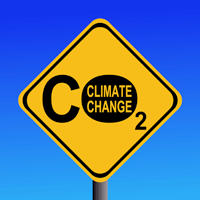
Denying Math and Science
/ David RobertsView the page for this story
Republican pundits often speak skeptically about climate change, just as they chose to ignore the mathematics projecting that their candidate would lose. Grist staff writer, David Roberts suggests that many Americans have the same attitude towards climate science; they ignore what they don’t want to believe is true. (05:15)
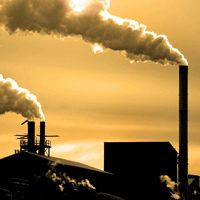
The Economics of a Carbon Tax
View the page for this story
Environmentalists have been talking about a carbon tax for years. The idea may finally be getting traction in Washington, as economists consider various tools to balance the budget this spring. Joe Aldy, a professor of Public Policy from Harvard’s Kennedy School joins Steve Curwood in the studio to discuss whether a carbon tax stands a chance. (09:25)
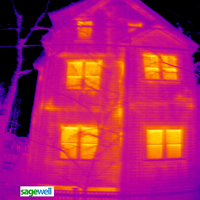
Power Shift - Thermal Imaging
/ Helen PalmerView the page for this story
MassSave takes pictures with a thermal camera that let you see with your own eyes where heat is leaking out of walls and windows in your home. It's a powerful spur to persuade you to improve insulation and keep the storm windows closed. Living on Earth’s Helen Palmer reports. (09:25)
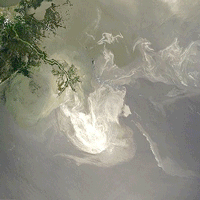
BP Pleads Guilty
View the page for this story
Oil giant BP will plead guilty to 11 felony counts and pay $4.5 billion to settle criminal charges in the Deepwater Horizon well disaster. Host Steve Curwood discusses the decision with William Reilly, co-chair of the Presidential Commission that investigated the disaster. (07:15)
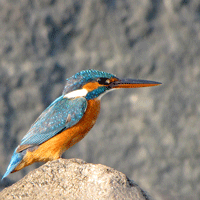
Design Inspiration from Nature
View the page for this story
When it comes to adaptation, Mother Nature knows best. Now, scientists are looking to Mother Nature for answers to some of our biggest environmental problems. Host Steve Curwood talks with Anamarija Frankic,(AN-uh-murr-EE-yuh FRAN - kitch) a Biomimicry Institute Fellow and Director of the Green Harbors Project at the University of Massachusetts, Boston. (03:30)

Mimicking a Beetle to Bring Water to the People
View the page for this story
A small start up company, inspired by a desert beetle, is using nano technology to develop a self-filling water bottle. Deckard Sorensen, co-founder of NBD Nano, tells host Steve Curwood how studying the Namib Desert Beetle helped them to develop new technologies for collecting water. (04:15)
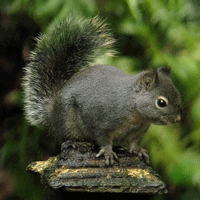
BirdNote ®: Douglas Squirrel
View the page for this story
The Douglas Squirrel can sound like a bird when its warning away intruders in its territory. Mary McCann has the story. (02:10)
Show Credits and Funders
Show Transcript
HOST: Steve Curwood
GUESTS: John Fasullo, Joe Aldy, William Reilly, Anamarija Frankic, Deckard Sorensen
REPORTERS: David Roberts, Helen Palmer, Mary McCann,
[THEME]
CURWOOD: From Public Radio International, this is Living on Earth. I'm Steve Curwood. A new survey suggests that the most extreme projections for global temperature rise are likely to be correct.
FASULLO: Some of these scenarios that we look at in these models are really quite alarming. It's a whole different world. The character of snow, of sea ice, the Arctic changes considerably. And that doesn't even touch on the question of adaptation and whether various parts of the environment we live in are going to be able to adapt to such a sudden shift in temperature zones.
CURWOOD: What that might mean for the future. Also, thermal pictures reveal where heat is leaking out of houses.
KAPLAN: The different colors will point your eye right to where your dollars are more or less flying out of your building.
CURWOOD: It could be the spur that makes people insulate their homes.
We'll have that story and more this week, on Living on Earth. Stick Around!
[THEME]
ANNOUNCER: Support for Living on Earth comes from Stonyfield Farm.
The Best Climate Projections Are Extreme
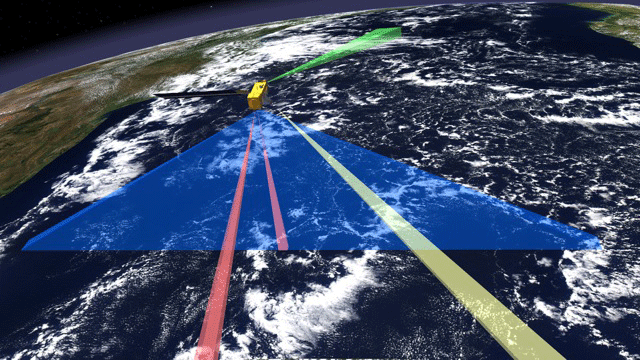
A NASA satellite used to gather information about cloud-related data linked to climate change (photo: John Fasullo)
CURWOOD: From the Jennifer and Ted Stanley Studios in Boston, this is Living on Earth. I'm Steve Curwood. The scientific consensus holds that climate change is upon us, but there are many different projections as to how fast it's happening - and how hot it might get. Now a new study has found that the most alarming global warming estimates may in fact be the most accurate.
Joining us is one of the report’s lead authors, John Fasullo, a climate scientist at the National Center for Atmospheric Research in Boulder, Colorado. Welcome to Living on Earth!
FASULLO: Thanks for having me.
CURWOOD: So, what are the various projections that have been made about the extent of global warming?
FASULLO: Well, we have a range of about three degrees Fahrenheit to about eight degrees. To make it more understandable, the basic question we’re trying to answer is whether or not New York City becomes more like Richmond, Virginia, in the future, or whether it becomes more like Atlanta, Georgia.
CURWOOD: Now, when you say three to eight degrees are you talking Fahrenheit or are you talking Celsius?
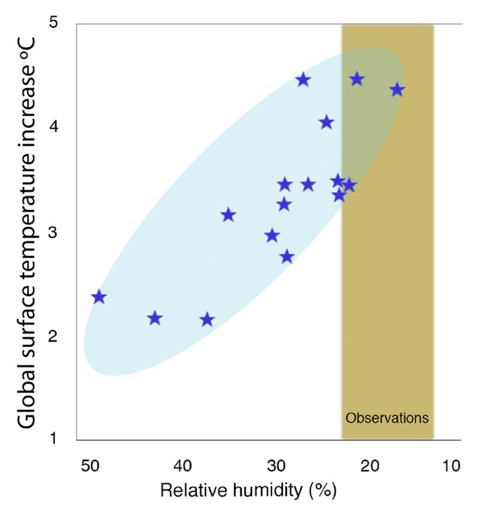
Graph detailing the results of Fasullo’s analysis (photo: John Fasullo)
FASULLO: We’re talking Fahrenheit and we’re talking by 2100. So, of course, there is the capacity for further warming after that, or if we take action to curb climate change, less warming eventually.
CURWOOD: So, why is there such a large range between these estimates?
FASULLO: Well, it all depends on how clouds change in the models. The largest source of uncertainty is how clouds will change in a warming environment. Some models suggest that clouds will increase and reflect more sunlight back to space while other models show clouds will actually decrease in extent and will actually let more sunlight into the system.
CURWOOD: So how did you take cloud cover into account for your analysis?
FASULLO: The evaluation of clouds in models is difficult, they’re a challenge because our observation of clouds are not too good, and then comparing those observations to models isn’t straightforward – it’s not an apples to apples comparison. So, we tried to skirt this whole issue by looking at the environment in which clouds occur, rather than clouds themselves. Things like relative humidity in the environment. And, over the past ten years, we’ve had NASA satellites that have observed relative humidity on a global scale throughout the atmosphere. And so, we’ve been able to take those observations and ask the question which models actually produce the relative humidity variations more accurately.
CURWOOD: Which of the projections ended up being the most accurate?
FASULLO: Well it turns out that there’s a set of models that is generally on the low end of the spectrum for projecting the future that does a very poor job in resolving these basic interactions that we see in the observations. There are these areas of the tropics called the dry zones, and we think of the tropics as being very moist, but in fact, once you get away from the surface of the tropics, most of the tropics is actually very dry.
These dry zones expand over time; you can think of this as the iris of the climate system. That iris opens up and the amount of clouds decreases, therefore letting more sunlight into the system and adding to additional warming. There is a set of models that’s generally doing this very well, and those tend to be on the higher end of the spectrum for projections.
CURWOOD: Which models are those?
FASULLO: One is from the UK MET office. One is from NCAR where I work in Boulder, Colorado, and one is from Japan.
CURWOOD: Now, the Intergovernmental Panel on Climate Change – that is made up of literally thousands of scientists from around the world – the models that they have accepted have consistently underestimated the extent of warming. Now why do you suppose that is?
FASULLO: Well, I think that body tends to be fairly apolitical, and is hesitant to make a judgment on which models are more reliable unless there is some very sound scientific basis for doing so. So they tend to weight all of the models in the scientific community evenly, even though we know that some of the models are better than others. So this is an attempt to provide an objective measure as to which models are doing the best. And therefore, maybe we should screen out a few of the models before we make a projection of what the future holds.
CURWOOD: What are the prospects of the Intergovernmental Panel on Climate Change, taking your research and applying it to their next series of reports, which come next year?
FASULLO: Well, they have included my analysis in their next report. And so it will be up to the authors on how they incorporate that information. It’s a very difficult problem, it’s been around for 30 years, and they’re going to be hesitant to make any bold proclamations based on a single study. And I think they should be. I think that science generally works by consensus and an evolving understanding of the issues.
So this will be one piece of evidence that they consider, but really there needs to be a broader effort across the scientific community to improve models and create a more complete picture as to what the possible future may hold.
CURWOOD: Based on your study, how hot do you think the world is going to get?
FASULLO: We feel that the upper half of the range of five degrees Fahrenheit to eight degrees Fahrenheit is probably most likely by 2100. But a lot of that warming is really up to us as well – how much are we going to emit into the atmosphere and how strongly are we going to force the climate system. And that is something that we can control and we should really make a focus.
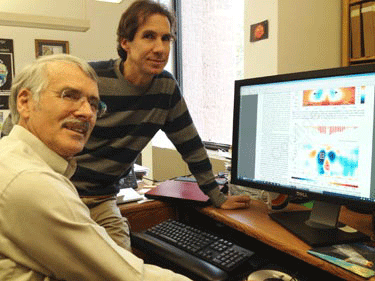
John Fasullo (right) and his Colleague at NCAR Kevin Trenberth (photo: John Fasullo)
CURWOOD: What would the world be like five degrees hotter?
FASULLO: Some of these scenarios that we look at in these models are really quite alarming. It’s a whole different world. The character of snow, of sea ice, of the Arctic changes considerably. And that doesn’t even touch on the question of adaptation – whether certain parts of our environment are going to be able to adapt to such a sudden and really large shift in temperature zones.
CURWOOD: What do you hope comes out of this research?
FASULLO: Well, we have two main messages. And one is, from a policy standpoint, we really need to consider the best science in forging the best policy concerning global warming. And it certainly is upon us and is going to continue to get worse. Putting our heads in the sand doesn’t help us prepare for the future that we’re getting into. The other message from our study is to model in communities. And to give a message as to how best to improve models so that we can better serve the needs of society.
CURWOOD: What’s it like to work on climate research in a nation where there’s been so much well-funded skepticism against this concept?
FASULLO: It’s a challenge. And I think most of the scientists who work in the field have a sense that eventually the truth will win out. But what’s frustrating is that we are, in some ways, racing against the clock. We keep emitting greenhouse gasses into the atmosphere and then wait to deal with it, we’re going to look at greater impacts overall with sea level rise and weather extremes. And so the more we delay action, the more expense we have to deal with instead of dealing with it inexpensively up front and as soon as possible.
CURWOOD: John Fasullo is a climate scientist at the National Center for Atmospheric Research in Boulder, Colorado. Thank you so much, John.
FASULLO: Thank you Steve.
Related links:
- Fasullo and Trenberth study in Science Magazine
- Info about the Climate and Global Dynamic division of the National Center for Atmospheric Research (NCAR)
- Met Office UK Climate Projections for 23 Countries including US
- Met Office UK Climate Modeling Methodology
- The Atmospheric and Ocean Research Institute (AORI) of the University of Tokyo
President Obama Speaks Out on Climate Action
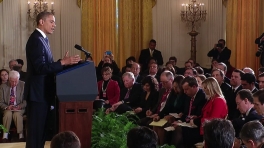
President Obama at White House Press Conference November 24, 2012
CURWOOD: In his first press conference after re-election, President Obama was asked about climate change, a topic that never came up in any of the campaign debates.
OBAMA: I am a firm believer that climate change is real, that it is impacted by human behavior and carbon emissions. And as a consequence, I think we’ve got an obligation to future generations to do something about it.
CURWOOD: But the president said comprehensive action can't come at the cost of jobs.
OBAMA: There’s no doubt that for us to take on climate change in a serious way would involve making some tough political choices, and you know, understandably, I think the American people right now have been so focused and will continue to be focused on our economy and jobs and growth that, you know, if the message is somehow we’re going to ignore jobs and growth simply to address climate change, I don’t think anybody’s going to go for that. I won’t go for that.
Related link:
Transcript of November 14, 2012 Presidential News Conference
Denying Math and Science

(photo: Bigstock)
CURWOOD: Well, whether or not the America people will go for it, climate change will not go away on its own. Just as Republicans chose to ignore the projections that their presidential candidate would lose this year, many Americans are choosing to ignore the projections that the global climate is headed for dire straits. At least that's the opinion of David Roberts, staff writer for Grist dot org.
ROBERTS: Perhaps the most striking thing about the recent presidential election is how predictable it was – or to put it another way, how predicted it was. From the moment Mitt Romney was chosen as the Republican candidate, the polls showed that Obama was on track for a narrow win in most swing states. For all the drama of the campaign, that polling remained remarkably stable, as reflected in the models of poll aggregators like the now-famous statistician Nate Silver. By the time Election Day rolled around, Silver showed Obama with an almost 90 percent chance of winning.
Yet on the day before the election, one-time Reagan speechwriter and long-time conservative pundit Peggy Noonan wrote a column predicting a Romney victory. Her evidence? I quote: “All the vibrations are right.”
Noonan was not alone. Dozens of conservative pundits predicted a Romney win, even a Romney landslide, dismissing models like Silver's as “scientific gobbledegook,” the overconfidence of pointy-headed nerds.
Well, you know how that turned out. To the great shock of the conservative intelligentsia and, reportedly, the Romney campaign itself, the results reflected the projections of political scientists and pollsters.

David Roberts (Grist)
The lesson here is twofold. First: the scientific method works. What Nate Silver has is not some superior ideology or truer faith. It is simply applied mathematics and reason, an approach that allows him to look past his personal prejudices and desires.
And secondly, doing what Nate Silver does and what scientists strive to do is extraordinarily difficult. Humans have an astonishing capacity for self-deception. We find reasons to believe what we want to believe, even if those reasons amount to little more than “vibrations.”
But as we saw on Election Day, sometimes reality can come along and snap the spell of wishful thinking. It happened the week before Election Day too. That's when a super-charged storm slammed into the east coast, leaving hundreds of thousands without homes or power. Sandy brought a heavy dose of reality and served as a kind of exclamation point on a year filled with droughts, wildfires, and floods – the hottest year ever recorded.
According to climatologists, it's just a taste of what's to come. Recently, scientists at the National Center for Atmospheric Research compared a range of climate forecasting to observed trends in cloud cover. What they found was the most pessimistic models have produced the most accurate predictions. They show us on track to raise the average global temperatures by as much as eight degrees Fahrenheit by the end of the century. That’s more than twice the level some scientists have identified as the threshold of serious danger. High enough, that some scientists doubt whether human civilization can survive it.
That is the grim news being brought to us by the Nate Silvers of climate science. And how have we reacted? Like a nation of Peggy Noonans. We don't want to believe it. It feels too scary to be true. So we dismiss it as extreme or alarmist. Some of us even dismiss the whole thing as a hoax. The “vibrations” just don't feel right.
And so, in a national election season filled with great clashes of vision and purpose, climate change was scarcely mentioned. But as shell-shocked Republican pundits can tell you, reality always bats last. We will listen to the science and take action, or we will lose this contest. And this loss will be permanent and irreversible. When it comes to the global climate, there are no recounts.
CURWOOD: David Roberts writes for the environmental news service, Grist dot org.
Related links:
- Grist
- Peggy Noonan’s Blog
[MUSIC: Greyboy All-Stars “Big Tito” from Soul Mosaic (Ubiquity Records 2004).]
CURWOOD: Just ahead – how the twists and turns of Washington’s fiscal showdown could result in a tax on carbon. Stay tuned to Living on Earth!
[CUTAWAY MUSIC: Hampton Hawes “The Awful Truth” from Four (Fantasy Records 1988 Reissue) Happy Birthday Hampton 11/13/28 – 5/22/77).]
The Economics of a Carbon Tax
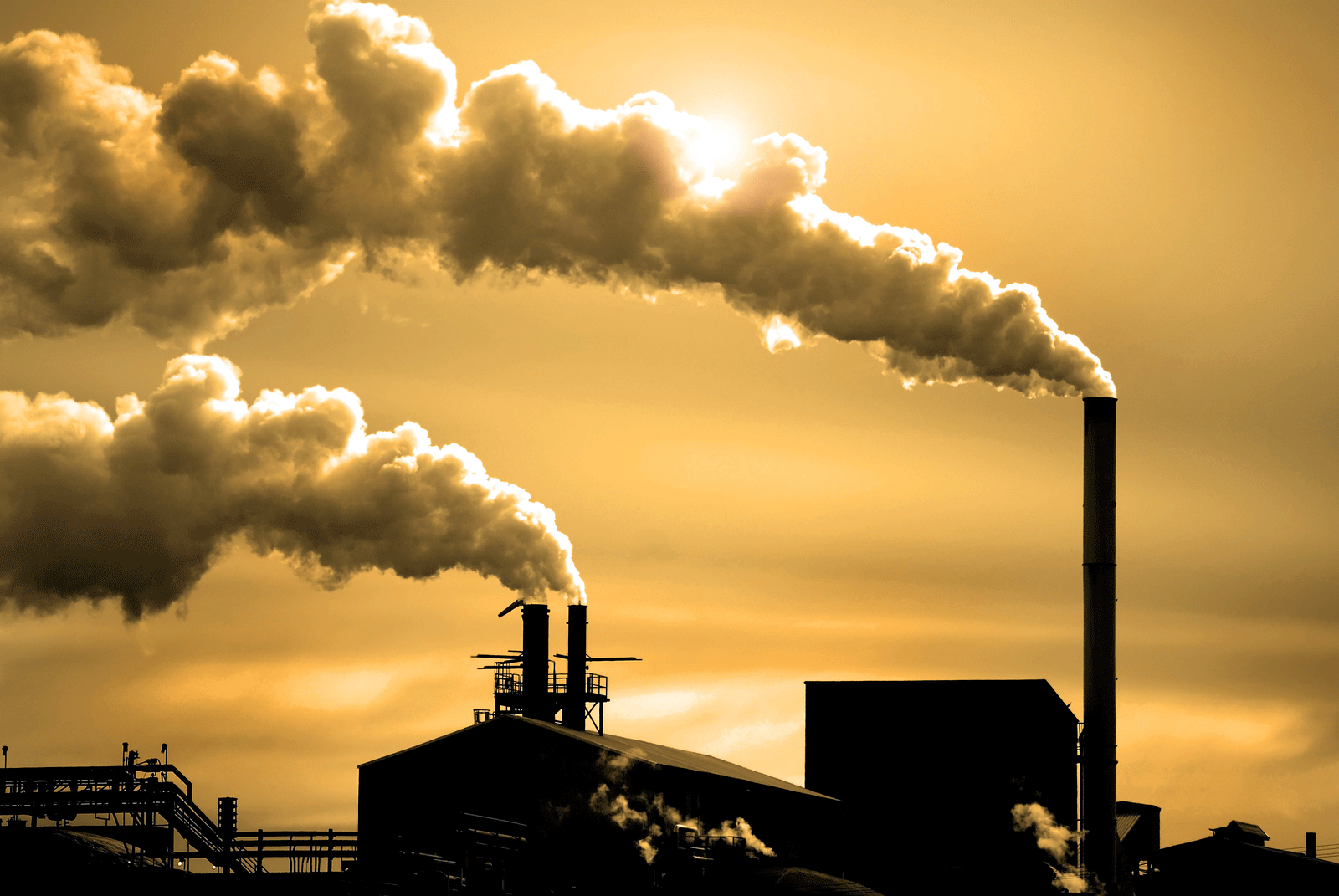
Pollution coming from factory smoke stacks (photo: Bigstock)
CURWOOD: It’s Living on Earth, I'm Steve Curwood. For years there’s been talk of a tax on carbon pollution as a way to fight global warming. But it’s gotten little traction until recently when both conservative and liberal economists have argued that a carbon tax could help cut the federal deficit and keep other taxes low. Joining us to discuss all this is Harvard economist Joe Aldy, a former aide to President Obama. Welcome to Living On Earth!
ALDY: Thank you, it's my pleasure to be here
CURWOOD: Professor Aldy, we asked you to come in because there seems to be all this excitement now in Washington about the prospect of carbon tax. There’s been a series of meetings and recently there was a standing room-only meeting at the American Enterprise Institute, which is known for being very conservative and skeptical of the whole notion of dealing with climate issues. Why is Washington suddenly so interested in a carbon tax?
ALDY: Well, I think there are a couple of reasons why Washington is interested in the carbon tax. One is, if you paired it with reducing tax rates, you can actually make our tax system more efficient. I think also it’s a function of the math; that when you look at all the alternatives to raising revenues or cutting spending in the tax or fiscal reform debate, there are actually not a lot of very palatable alternatives.
And all of a sudden a carbon tax looks more appealing when you compare it to, say, increasing the payroll tax by two percent. People have talked about the reduction in spending on defense and on entitlements; it’s also on par with the home interest deduction. Some people say if we got rid of the home interest deduction that would help close the budget deficit and deal with our long-term debt problems.
None of those are easy options, and I think that when you look at the potential revenue that a carbon tax can raise, that looks more appealing than having to go down some of these other avenues.
CURWOOD: So explain to us a the concept of a carbon tax – how would this work?
ALDY: So the basic idea of a carbon tax is to say that all of the sources of carbon dioxide ¬– the most important greenhouse gas – would actually have to bear the cost that they have on the global environment. So, you would actually impose a tax for every ton of carbon dioxide that’s emitted when we burn a ton of coal, or natural gas or we burn oil and petroleum products.
CURWOOD: So where in the world has a carbon tax been used so far?
ALDY: So we’ve seen it in a number of places. A number of northern European countries have actually had a carbon tax on the books and in place dating back to the early 1990s. So, Sweden, Finland, Norway and Denmark have all had carbon taxes in their energy system. Some of the carbon taxes range anywhere from 20-100 dollars per ton of CO2, which are actually quite meaningful, and in some cases larger than what we would consider here in the United States.
I think most relevant when we think about it in the context of the current fiscal environment, is what British Columbia implemented in 2008. The province of British Columbia imposed a carbon tax, and they used all the revenues to reduce existing household taxes on…for family income, and business taxes, a 50-50 split between families and businesses.
They ramped the tax up, it’s now 30 dollars a ton of CO2, so they set at the beginning a schedule where the price would increase over time. But at the end of the year, they take all of the revenues, they don’t increase the size of the government, they’re actually saying we’re going to reduce the taxes that families and businesses pay, and it’s actually had a pro-growth impact.
And I think that’s one of the important things about this in fiscal reform, is by raising revenues through carbon tax – by putting a tax on something bad like pollution – we can reduce taxes on things that are good, like the income that families earn and that businesses earn.
CURWOOD: So how successful has the carbon tax been in places like British Columbia?
ALDY: Well, you’ve actually seen their emissions go down, you’ve seen their consumption of petroleum actually go down relative to other parts of Canada. Even if the price starts out modest at the beginning, if you show the schedule of how the price will increase overtime, when businesses are making investments, when a family is thinking about buying a new car or a new home, they can take this into account in their planning. And that means they’ll make prudent investments in energy efficiency and alternative energy sources that help reduce their emissions over time.
CURWOOD: Professor Aldy, you’re an economist, so help us with some math here: How could a carbon tax help reduce this enormous deficit that we have?
ALDY: So I was at this conference in Washington that discussed a carbon tax. The kind of magnitude of carbon tax that was commonly raised was on the order of about 100 billion dollars or 150 billion dollars a year. This would be associated with a tax that would increase in the price of gasoline, maybe 15 cents a gallon. So this is something that people would actually see, but if you actually raise the tax on the order of 100-150 billion dollars a year, over a decade, that’s more than a trillion dollars.
When you look at the kinds of proposals on the table to reduce taxes, to shore up the long-term deficit outlook, having a trillion dollar piece of the pie there, if you will, that helps make all the math add up, is going to be really important.
CURWOOD: Carbon tax would inevitably mean higher price at the pump, more expensive electricity - how are people going to come to accept this?
ALDY: Well, I think the important thing is that we’re discussing a carbon tax in the context of what would be a very large tax and fiscal deal. So when one says: ‘Well, look, I’m going to be paying a little bit more for gasoline, or a little bit more for electricity,’ it may be in the context of a deal that also keeps the income tax rates for the vast majority of Americans at the level we’ve enjoyed over the past decade. If we don’t do anything, they go up on January 1.
So, it’s recognizing that there are going to be these trade offs and for a lot of people they’ll find that they may be better off if they face lower rates of tax on their income, even if that means they pay a little bit more for the energy-intensive, emissions-intensive consumption that they entertain.
CURWOOD: Some folks will say, though, this is a regressive tax, especially for really poor people who don’t have the benefit of other tax rates. If you don’t pay tax already and the price of gasoline goes up because there’s a carbon tax, it hurts you. How do you address that?
ALDY: Well, I think that there are a number of ways in which one can try to mitigate these concerns. I’ll note that in 2009, several Republicans in the House introduced a carbon tax bill. One of whom was recently elected to be the junior Senator from Arizona, Jeff Flake. In that bill, they were concerned about the impacts of a carbon tax on the elderly, on people who collected social security. So cutting the payroll tax doesn’t really benefit you if you’re retired. They actually take some of the revenues from the carbon tax and increase the benefits that would be paid out to social security.
CURWOOD: And what about somebody who’s living from paycheck to paycheck, you know, a young person who’s got a very low income job, maybe working in a fast food restaurant and needs to put gas in that car to get to that job, he’s not going to get to Social Security, he doesn’t even have to pay taxes… all he sees is the price going up.
ALDY: Well, let’s be clear, though, that person who is working minimum wage, might not be paying income taxes, but that person is paying payroll taxes. One could actually look at using a carbon tax, in part, to reduce the tax on labor, which a lot of economist would say: ‘Hey, that could actually be good for jobs, it would be good for the economy if we reduce the taxes on labor,’ and so, even if you’re not paying income taxes every April, you’re paying with every paycheck; your employer is withholding payroll tax. So there’s a way in which you can actually help out even those individuals by the way you take the carbon tax revenues and bring them back into the economy.
CURWOOD: It takes a long time to get things done in Washington. I’m guessing this doesn’t happen in the lame duck session we’re looking at over the next couple of weeks.
ALDY: You know, it’s one of these things where sometimes it takes a while for the impossible to become plausible, and then become inevitable. Sometimes it happens very quickly… I’m probably not going to go to Vegas and bet on it happening in the lame duck, but it depends on how these talks evolve. I think it’s probably more likely that we’ll do a short-term fix in the lame duck, but we’ll probably structure it in a way where we’re going to see a bigger, longer-term, more robust agreement, hopefully in 2013.
CURWOOD: How much do you think superstorm Sandy has affected the debate on carbon tax?
ALDY: You know it’s interesting. When I talked to a friend about some of the images that we saw from New York and New Jersey, he actually said, these pictures remind me of Bangladesh after a bad monsoon season. Just seeing this unbelievable amount of destruction of the roads and the bridges and the infrastructure, and houses completely wiped out… and I think it’s important to really say: ‘We know climate change can actually pose real damage to us here in the United States.’
And whether we say Sandy was the function of climate change or not, we do know from the best scientists out there that storms like Sandy are going to become more common. Being able to say, ‘Wait, if we don’t do anything about this, we’re going to see more storms like Sandy. We’re going to see more droughts, like what we’ve been experiencing here in the United States over the last couple of years.’
I think that actually will create more interest for people to say: ‘Well, what can we do about this? How can we take action?’ And being able to identify some of the policy tools at our disposal, I think we’ll encourage the public to say, ‘You know what? Let’s try that idea. Let’s make a difference in terms of how we produce and consumer our energy, and recognize that we can do this in a way that’s actually good for our economy.’
CURWOOD: Joe Aldy is an economist who teaches at the Kennedy School of Government at Harvard. Thanks so much for coming in, Joe.
[MUSIC: Neil Young “Ramada Inn” from Psychedelic Pill (Reprise Records 2012).]
ALDY: Thank you for having me, I've enjoyed it.
Related links:
- Joseph Aldy
- Report: A Tax-Based Approach to Slowing Global Climate Change
[MUSIC CONTINUES]
Power Shift - Thermal Imaging
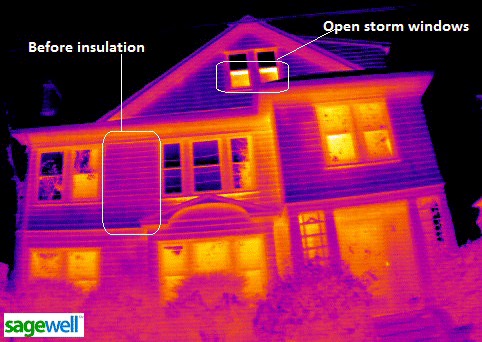
CURWOOD: The cheapest energy is the energy never used – and that’s an incentive to seal up houses to get rid of drafts. But you can't see leaks, and the conventional blower tests that are used to find them can be expensive and annoying. Now there’s a revolution in draft detection, and it’s called thermal imaging. A heat-sensing camera can quickly and cheaply snap a thermal picture that reveals heat loss.
Where a house is well insulated the image glows a cool blue, and warm red – or even white – shows up where heat is escaping. Thermal images of homes are now being created in many states – and Massachusetts householders are among the leaders in checking them out and taking action. Living on Earth's Helen Palmer has the story from a street famous for reenacting the start of another revolution more than two hundred years ago.
[HORSE AND STREET SOUNDS]
PALMER: Every April, Paul Revere gallops from Boston out west through Arlington to warn the Minutemen of the approaching army. “The Red-Coats are coming!” he shouts. Well this fine November day – the weatherizers are coming – to Paul Revere Road in Arlington.
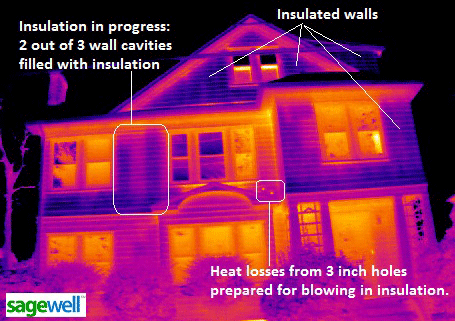
After insulation treatment
DANIELS: My name is Leah Daniels. We do weatherization, insulation services, help people shrink their carbon footprint by insulating their walls thereby saving them money on their heating bills and heating costs.
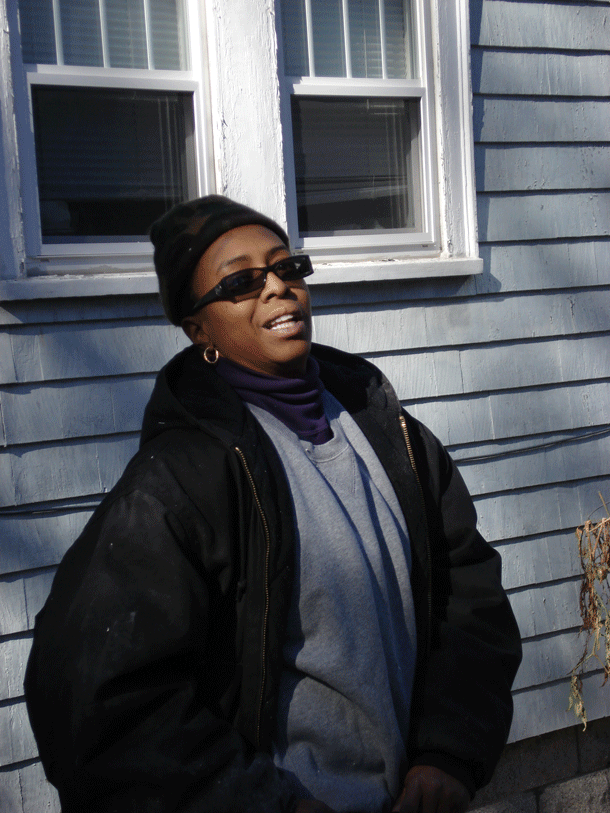
Leah Daniels, CEO of Green Beginnings. (Photo: Helen Palmer)
PALMER: Daniels is a veteran. Her company, Green Beginnings, is one of dozens certified by Mass-Save, an energy-saving program funded by utilities and contractors in the Bay State. Mass-Save offers energy audits, retrofits, rebates and energy saving products and ideas to homeowners and renters. Today, Daniels and her crew are preparing to fill all the spaces in the floors and walls of this big old New England triple decker with insulation.
[KNOCKING, SQUEAKS OF CONSTRUCTION]
PALMER: This means they have to pull up floorboards in the attic…
[DRILLING SOUNDS]
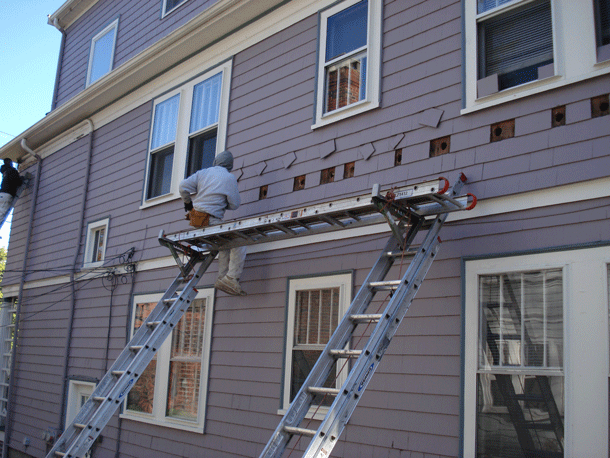
Holes drilled in the house ready for insulation. (Photo: Helen Palmer)
PALMER: …and pry off some shingles to drill holes in the side of the house. So these holes are about 2 inches across…
DANIELS: 2 and 9/16ths to be exact
PALMER: 2 and 9/16ths…and that’s so you can shove in the hose with the insulation?
DANIELS: Correct.
PALMER: The hose is wide and white - it snakes along the ground from a large grey hopper in Daniels’ van and up through a window into the attic, where the crew is already blowing the fluffy gray insulation into the gaps between the joists.
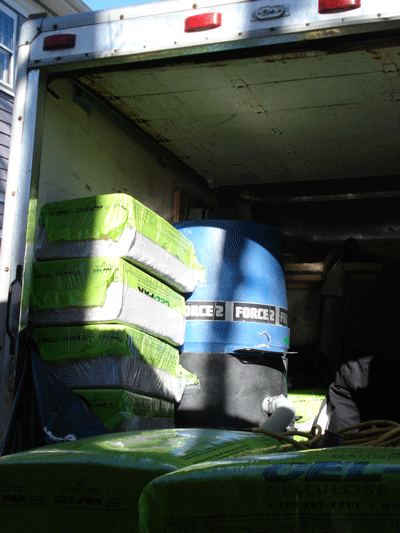
The hopper that forces the insulation into the house; the bales are the cellulose insulating material. (Photo: Helen Palmer)
[HOPPER BLOWING SOUNDS]
DANIELS: It’s just ground up newspapers – all the old newspapers that you don’t read go to this company and they just chop it down to really, really fine and so when it gets into the walls it dense packs itself, so it gives you a thermal barrier from the outside air temp to the inside air temperature.
[BLOWER NOISE, HAMMERING]
PALMER: Part of what persuaded the homeowners to improve their insulation was a thermal image of their house. Pasi Mietinnen is CEO of a company called Sagewell that provides these images.
MIETINNEN: You can think of it as Google Street View – except in measuring heat coming out of the building. So we have anywhere from 4-5 pictures and sometimes more of your house from the street and what it shows is heat escaping from the building through the windows, the doors, the basement, wherever heat comes out.
PALMER: The images of this house showed plenty of room for saving energy, and cash, but that wasn’t the only thing that persuaded the home-owners, Steve Simon and Fran Kuebler to call in the energy-saving team today.
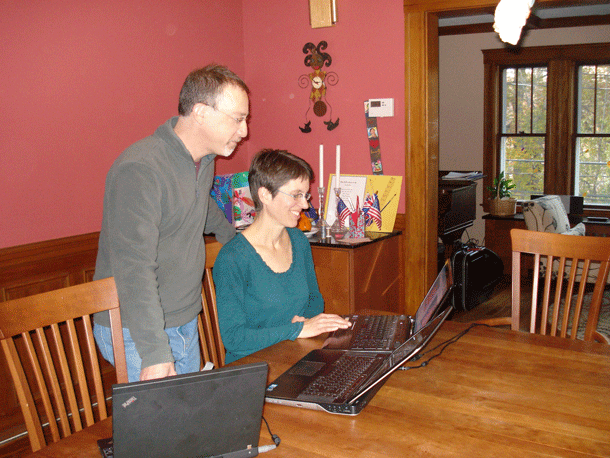
Fran Kuebler and Steve Simon examine the thermal pictures. (Photo: Helen Palmer)
KUEBLER: Well I’m a person who always feels cold – so I would love to have the thermostat nice and high and toasty all the time, but I realize that’s not good for the bills or the environment.
SIMON: Her husband won’t let her do that!
PALMER: So Steven, were the bills part of the incentive to get it done?
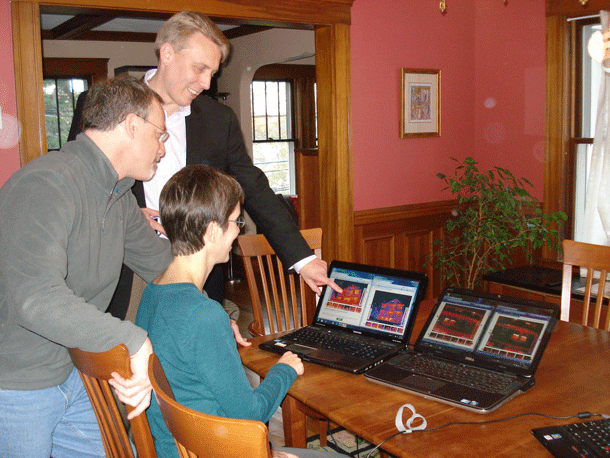
Pasi Miettinen shows Fran and Steve before and after thermal images of their home. (Photo: Helen Palmer)
SIMON: I think the bills, yes; I think looking at the pictures certainly were a factor, and I think when you study the incentives that are available to the homeowner, I think it’s a no-brainer decision, you make the money back pretty quickly.
PALMER: And you have a warm cozy house as well. After the crew finished the insulation, Sagewell took some new thermal views. Mietinnen lined up a couple of computers to show Fran and Steve the post and pre-insulation pictures.
MIETTINEN: The walls on 2nd floor that were not insulated are bright on the top, and as the insulation has been sagging, it gets cooler and cooler on bottom of that wall and you also had a couple… at least one window, storm window that was open there that’s easy to fix.
SIMON: I must say the pictures are a great incentive to keep the storm windows down – they very much work!
MIETTINEN: So, now when you look at post-insulation images what you’ll see is the walls are considerably cooler. Now you see a lot more blue – where you used to see orange, which indicated a higher temperature. So the walls are considerable cooler now.
PALMER: So now you’ve seen the, as it were, the before and after – what’s your reaction?
SIMON: I’m impressed – I think it’s a very powerful tool to give you the incentive to do it to begin with, clearly you can see the results. It’s fabulous.
PALMER: That reaction would please Sue Kaplan. She’s the acting director of energy efficiency at Massachusetts’ Department of Energy Resources – and something of a fan of thermal imaging.
KAPLAN: The different colors will point your eye right to where your dollars are more or less flying out of your building. And, you know, it’s one of the things we're testing to see whether it’s as powerful a motivator as we think it may be. The Department of Energy Resources has a grant from the Department of Energy and the federal government to test how well thermal imaging contributes to people’s interest in investing in their homes so that their bills can potentially decrease.
PALMER: Kaplan says the results aren’t in yet, but Pasi Miettinen says his company has seen a lot of interest in the images. They now have pictures of over 400,000 houses in Massachusetts, and each night add another 10-20,000 buildings to that total – the images are available free to householder's on Sagewell’s website.
He expects to have thermal pictures of most of the colder states in the country in a couple of years. As for Massachusetts, he says 15% of people getting energy audits now do so after visiting his website and seeing where they’re losing heat. I wanted to see for myself - so he brought his imaging van round to my house, and we went for a drive with the company’s energy efficiency analyst Jennifer Mussoff.
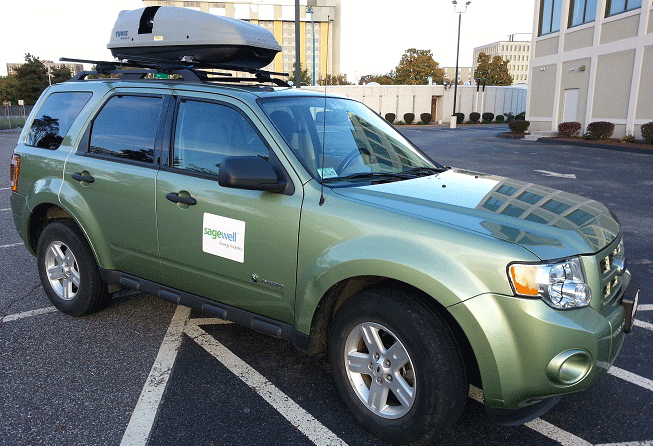
Sagewell Imaging Vehicle
[VAN SOUNDS]
MUSSOFF: It’s a lot different to look at a thermal image than it is to look at a picture you might take with your camera or your smart phone.
PALMER: Yes, it’s so different - you’ve got the blue houses and the black sky!
MUSSOFF: Mmhmm. Each temp reading is given a color representation.
PALMER: And can you capture these as you drive by at 30 mph?
MUSSOFF: Absolutely, we’re capturing right now. You know, it’s New England – a lot of people have trees and shrubs in their front yard, for example this house on the right has lots of bushes. You can't see though fences, can’t see through trees, absolutely can’t see through windows.
PALMER: But she did have an image of my house – and showed it to me:
MUSSOFF: You can see that there is quite a bit of insulation, you can see the studs and the pattern of the beams that surround the insulation itself - but overall I'd have to say the front view of your house shows so much insulation is there that you're doing quite well.
PALMER: Which is a relief – as we paid to get the work done – and it has paid off in lower heating bills. Indeed, Massachusetts efficiency chief Sue Kaplan says each dollar invested in insulation and other improvements returns $4 to the householder, and the push to save energy in the state is getting results.
KAPLAN: We have been ranked both last year and this year as the most energy efficient state in the country - and that’s not only in the policies - but the level of investment and the level of savings.
PALMER: Still, people often need a push to decide to actually get the job done – and the pictures – with the bright oranges and reds and whites showing where you’re heating the atmosphere outside your home -- can have that effect for many folks. Pasi Mietinnen has an apt analogy.
MIETINNEN: What we tend to say is that if you had a water leak in your basement, of course you would call a plumber – but if you have a heat leak in your building, you don't see it until you look at it in a thermal image. And a lot of people, when they see the imagery of their house, they have one of these moments where they go: ‘Wow I really need to do something about this right now,’ and that’s how a lot of insulation takes place.
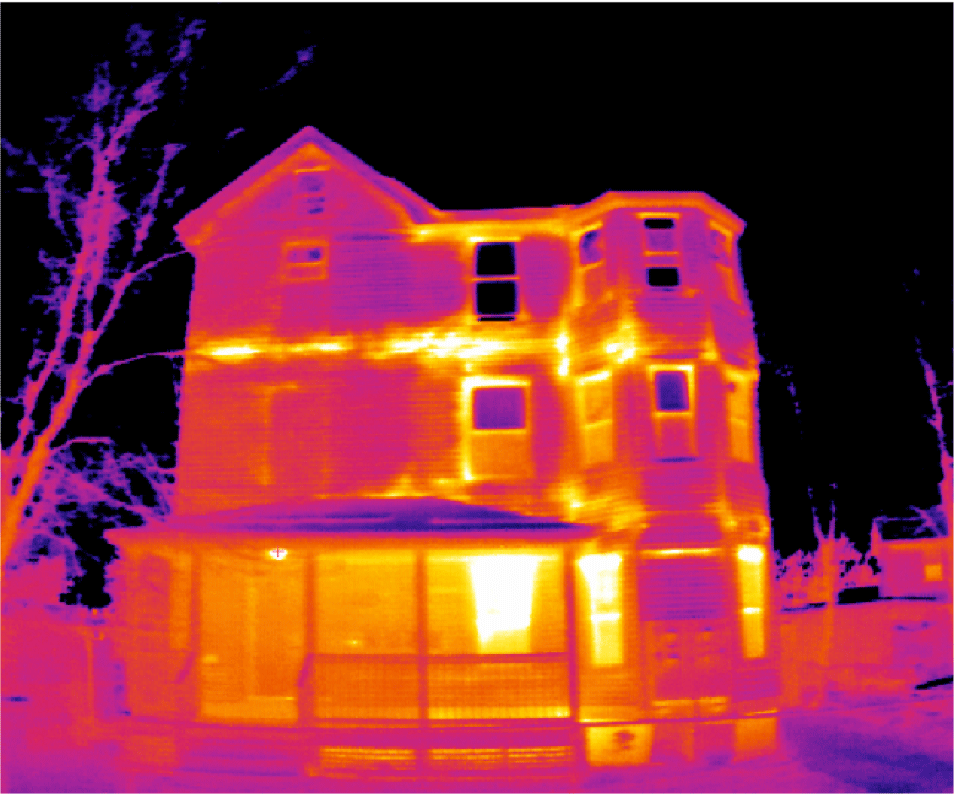
PALMER: And that pays off for homeowners – and for contractors like Leah Daniels.
DANIELS: Once you start to turn the heat on and you get the first bill - everybody’s like Oh my God!
PALMER: Have you done your own house?
DANIELS: (Laughs) Amazing you say that… Yeah my room mate handed me the gas bill one afternoon, and told me he was going to refuse to pay this bill until we insulated the house. So, yes, my own house is done and our gas bill went from about $700 a month to about 2 and a quarter, 250, so he’s happy. (Laughs).
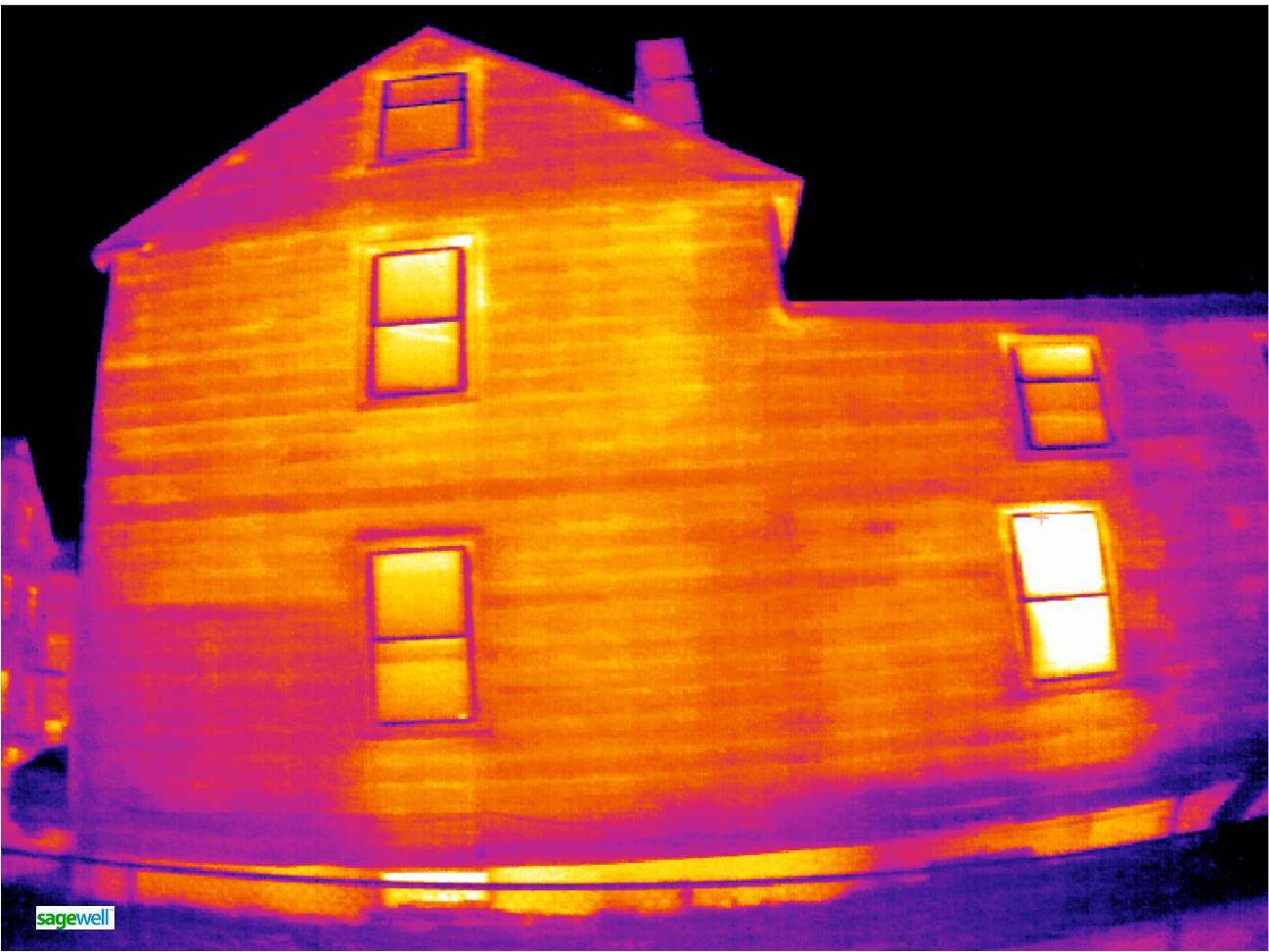
CAPTION (Photo: CREDIT)
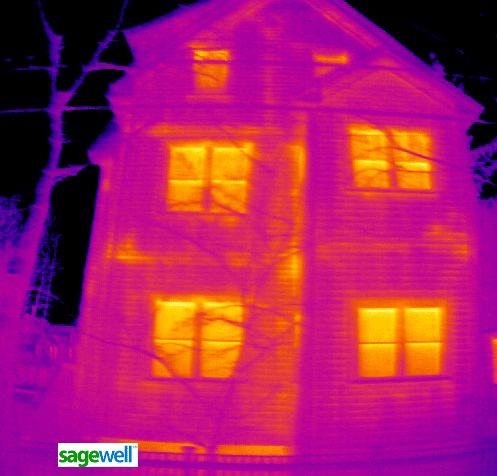
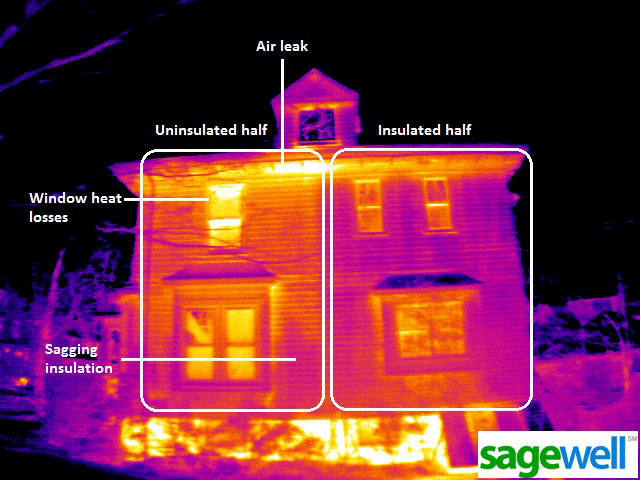
A half-insulated home in Belmont, MA
PALMER: Well, I guess you’re happy too!
DANIELS: (Laughs.) Yeah, we get along better!
PALMER: Which just could be one of the best arguments there is for taking action. For Living on Earth, I'm Helen Palmer.
[MUSIC: Jorma Kaukonen “Midnight in Milpitas” from Quah (BMG Heritage 1973).]
CURWOOD: Check out some of the thermal images – and more -- at our website loe dot org. Coming up – a record criminal fine for BP for the Gulf oil spill is not the end of the story. Keep listening to Living on Earth!
Related links:
- Thermal Images
- Mass Dept of Energy Resources
- Mass-Save
[CUTAWAY MUSIC: Various Artists/Wild Horses: “Beast Of Burden” from Wild Horse: Rolling Stones Instrumental Renditions (Purple Pyramid Records 2008)]
ANNOUNCER: Funding for Living on Earth comes from the Grantham Foundation for the protection of the environment, supporting strategic communications and collaboration in solving the world’s most pressing environmental problems. The Gordon and Betty Moore Foundation. The Kendeda Fund, furthering the values that contribute to a healthy planet. And Gilman Ordway for coverage of conservation and environmental change. This is PRI, Public Radio International.
BP Pleads Guilty
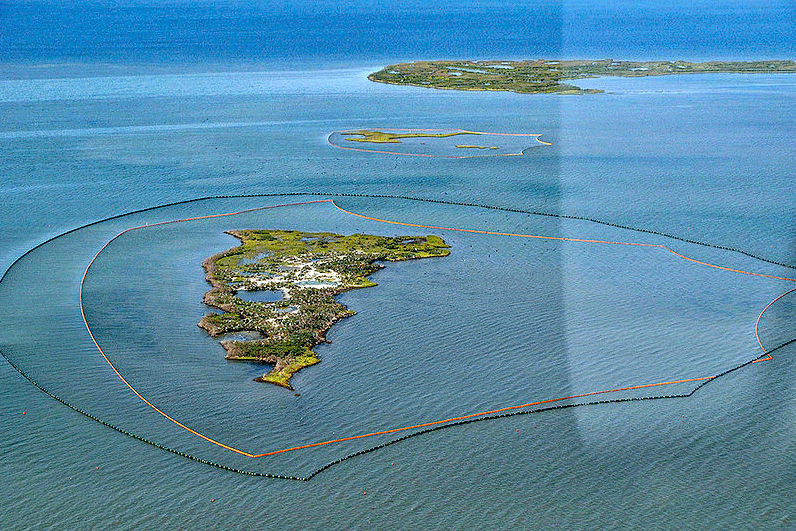
An oil containment boom deployed by U.S. Navy Supervisor of Salvage and Diving personnel surrounds New Harbor Island, La. to mitigate environmental damage from the Deepwater Horizon oil spill. (Photo: http://www.wikipedia.org/).
CURWOOD: It's Living On Earth, I'm Steve Curwood. Oil giant BP will pay a record $4.5 billion fine to settle criminal charges relating to the 2010 oil disaster in the Gulf of Mexico. The company agreed to plead guilty to 11 counts of felony misconduct after the Macondo well explosion that killed 11 workers and spewed nearly five million barrels of oil into the Gulf. BP will also plead guilty to misdemeanors under the Clean Water and Migratory Bird Treaty Acts, and a felony count of obstruction of Congress.
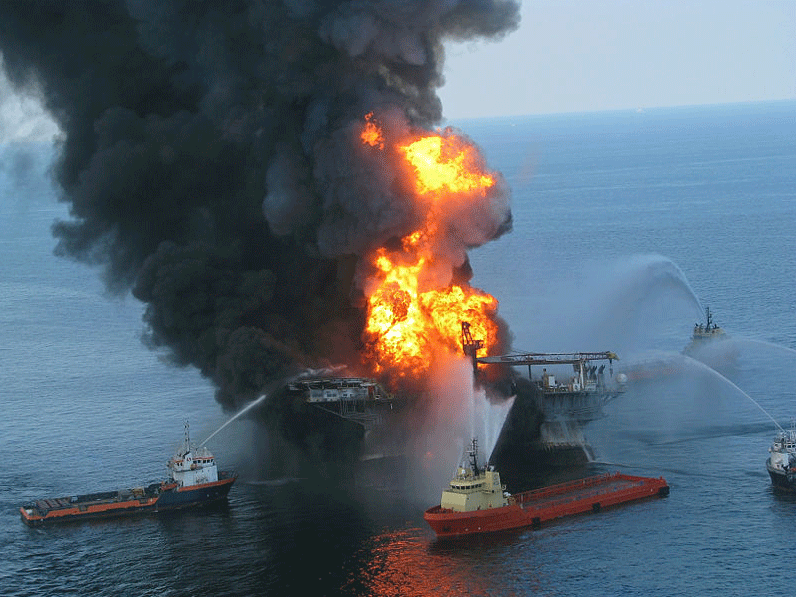
Deepwater Horizon offshore drilling unit on fire (Photo: http://www.wikipedia.org/).
Most of the company’s felony charges relate to misinterpreting pressure readings that showed leaks in the wellhead of the Deepwater Horizon rig. In addition, two senior BP supervisors face trial for manslaughter related the deaths of the 11 workers. Joining us by phone now from Beijing is William Reilly; he co-chaired the National Commission on the BP Deepwater Oil Spill and Off-shore Drilling. Hello!
REILLLY: Good day Steve!
CURWOOD: So, what’s your take on the settlement of criminal charges with BP?
REILLLY: With anything of this sort, the government wants to establish something of a warning, a precedent, send a signal, and generally mete out some punishment. I think all of those objectives were met in the agreement that has just been reached – in the findings that have just been reached.
The negative pressure test, which is the basis for most of the criminal counts, certainly was misinterpreted, and it very clearly appears that was negligently so. One of the two people who was monitoring the negative pressure test did not survive the disaster, and so there are certain things that was not known about it.
But there was an indication; there were two negative pressure tests, and an indication from one of gas rising in the bill pipe. And that was ignored in favor of a second test, which also was conducted a somewhat different way, which indicated no change in pressure. So I think the basis for the conclusions is sound, given what the commission concluded, and I’m not surprised.
CURWOOD: So, this is what you expected?
REILLLY: Yes. I think given the… there are a couple of things in there that surprised me… the obstruction of Congress findings based on misrepresentation of the flow rate. And that surprised me a little bit, because it struck me that there was much confusion about it on the part of the company, and certainly of the government, which led to a lot of concern, and I think some loss of confidence on the part of the public in the government and the company in the early days of the spill.
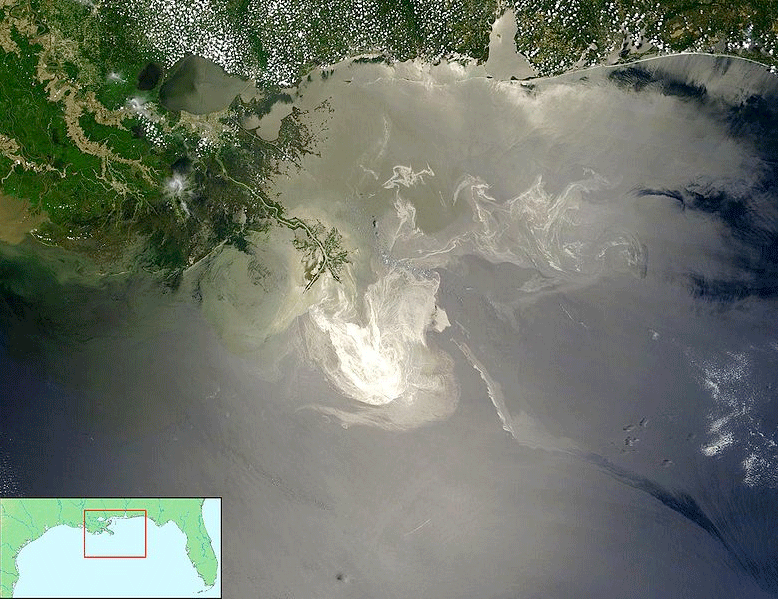
NASA's Terra Satellites Sees Deepwater Horizon oil spill on May 24, 2010. (Photo: http://www.wikipedia.org/).
And it wasn’t entirely clear to me that that was anything more than the failure to have the kind of technology that would allow you to make that determination. But it was certainly a very important mistake, and BP has paid the price for it. I have no question in the future, and we’ve been assured by the head of the USGS Marcia McNutt, that it would not take more than a couple of weeks to determine the flow rate, if there were, lord forbid, another accident of that sort.
CURWOOD: So, it’s a $4 billion dollar settlement, it surpasses the $1.3 billion that was levied against Pfizer for marketing fraud back in 2009… the biggest criminal settlement against a company… the right size?
REILLY: Well, in any accident of this sort, I’m sure the Justice Department is concerned about proportion. And this was a wholly disproportionate accident; we’ve never had anything happen like this before. It did take lives. The Exxon Valdez disaster which involved in $1.1 billion dollar settlements against the company, did not involve loss of life, and certainly it involved much less disruption, and of course occurred in a less populated area.
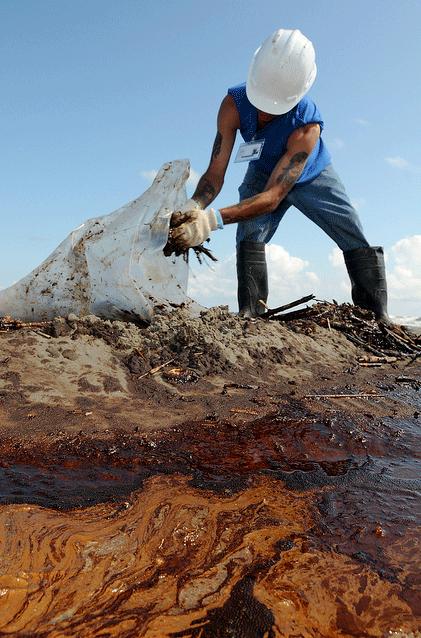
Contractors Assist in Deepwater Horizon Spill (Photo: DVIDSHUB)
So I don’t think this is inconsistent with the very extensive damage that was caused, the disruption of people’s lives. Some 47,000 people were involved in the cleanup and many, many more suffered loss of income, some loss of business. I think this is quite an appropriate reflection of the seriousness of what occurred.
CURWOOD: How much does this reflect care about the environment?
REILLY: The Migratory Bird Species count is a clear signal, as is the allocation of a significant amount of penalties that are being paid over five years to the Fish and Wildlife Foundation. I think it very strongly includes an element of acknowledgement that the environment suffered just as people did.
CURWOOD: We’re getting some feedback from the Gulf Coast region among the locals that BP is getting off lightly – they’re not too happy about that. What would you say to them?
REILLY: This is not the end of the affair. Obviously, civil claims still exist against the company, and one will await the negotiations of those types of settlements. I have heard that those settlements are relatively near, but there is clearly more to come.
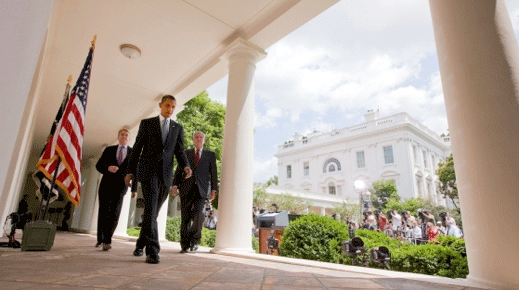
President Barack Obama and BP Oil Spill Commission co-chairs, former EPA Administrator William Reilly, left, and former Sen. Bob Graham of Florida, right, walk back to the Oval Office after speaking to the media in the Rose Garden of the White House, June 1, 2010. (Official White House Photo by Chuck Kennedy) June 1, 2010. (Official White House Photo by Chuck Kennedy)
CURWOOD: Of course, there are other companies involved with this, I’m thinking of TransOcean, I’m thinking of Halliburton - what does this criminal settlement with BP suggest might happen with those companies?
REILLY: Well, I won’t really comment on the likelihood of criminal charges against other companies, but just to say that the Commission did conclude that significant mistakes were made by the other two principal companies ¬– the service companies – and no doubt that they will be involved with something going forward with the government.
CURWOOD: Bill Reilly, what does this criminal settlement with BP tell us about the company’s future for drilling in this country?
REILLY: Well, we were asked quite often, I was asked in Alaska, whether BP should be precluded from continuing from to operate in the north slope in Alaska, and I said, what I believe then and believe even more strongly now, that companies learn from their mistakes. Some of the safest companies have had their disasters and gotten to be models, model citizens for environmental concern and protection.
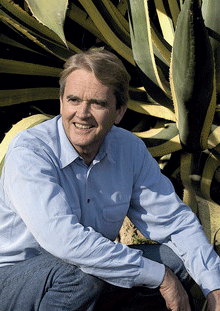
William K. Reilly. (Photo: http://worldwildlife.org/leaders/william-k-reilly).
I think that Exxon Mobil after Exxon Valdez went through a transformation that has left it in the minds of many oil industry figures and others among the safest of companies. So, BP clearly has set about policies that go beyond regulations in many areas, and I think they’ve taken this to heart. And so I think one can expect that BP will do everything that one can expect of BP in the future to comply with the law and to exceed some of the requirements, in fact, under the regulations.
CURWOOD: Well, thank you for taking this time with me today.
REILLY: Very pleased to do it. This closes an important chapter in a very sad history of the accident that occurred in 2010.
CURWOOD: Former EPA Administrator, William Reilly, co-chaired the National Commission on the BP Deepwater Oil Spill and Offshore Drilling.
Related links:
- Statement of the US Department of Justice on BP’s criminal fines and the manslaughter indictments of two senior BP supervisors
- Final report by the National Commission on the Deepwater Horizon Oil Spill and Offshore Drilling
- BP’s Statement About the Plea Bargain Deal to Resolve US Federal Government Criminal and SEC Claims Against BP in Connection with the Deepwater Horizon Incident
[Scofield, Medeski, Martin & Wood “In Case The World Changes It’s Mind” from MSMW Live: In Case the World Changes It’s Mind (Indirecto Records 2011).]
Design Inspiration from Nature
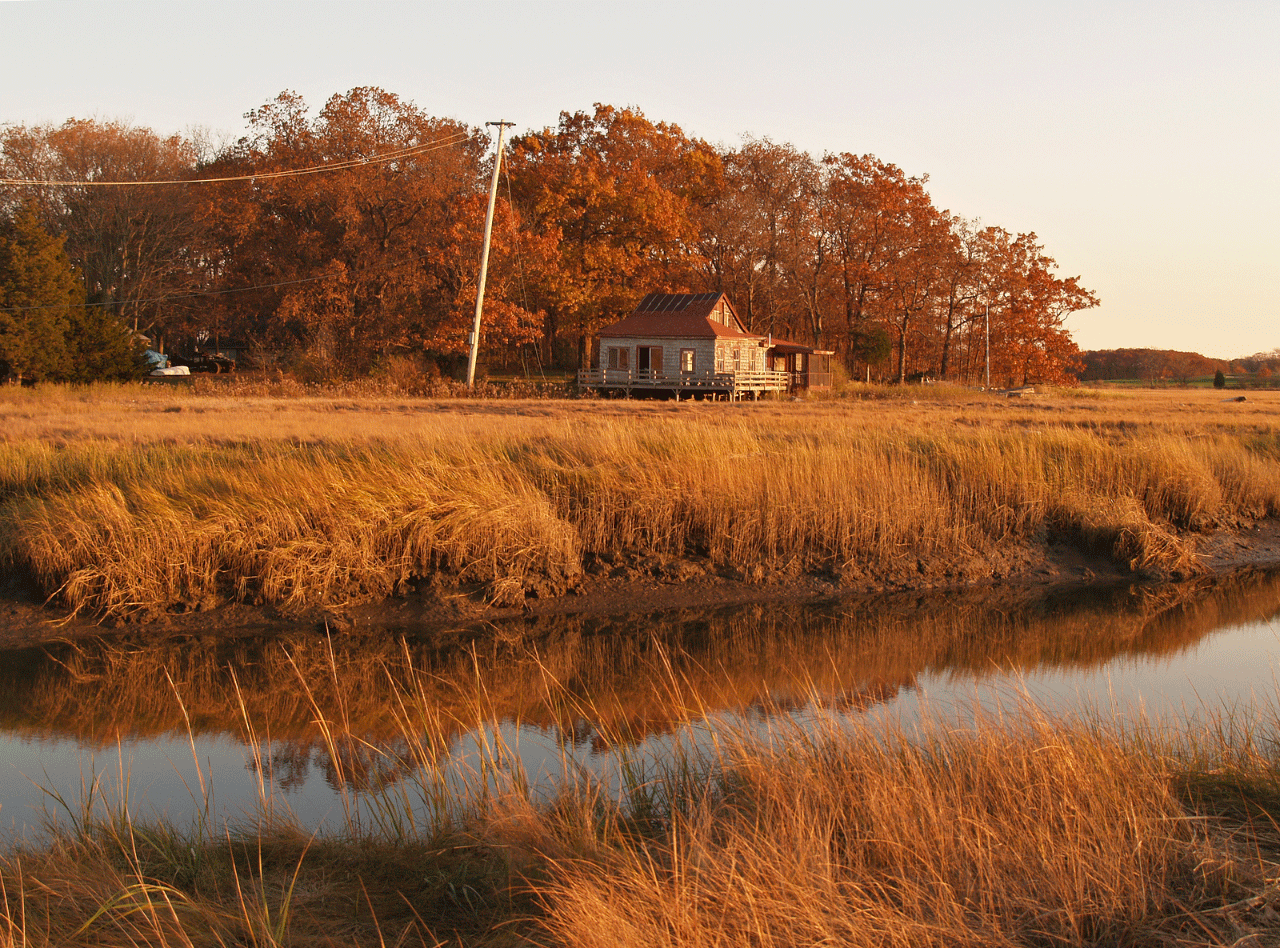
Salt marshes provide critical ecological services such as nutrient cycling and water filtration. (photo: Bigstock).
CURWOOD: When it comes to adaptation, Mother Nature knows best. It makes sense, then, that mimicking nature may be the best way to cope with all sorts of challenges. Here to talk with us is Anamarija Frankic, a fellow at the Biomimicry Institute at the University of Massachusetts, Boston and Director of the Green Harbors Project. Welcome to Living on Earth!
FRANKIC: Hi, thank you for having me!
CURWOOD: Just for a basic explainer, what is biomimicry and why should we focus on it?
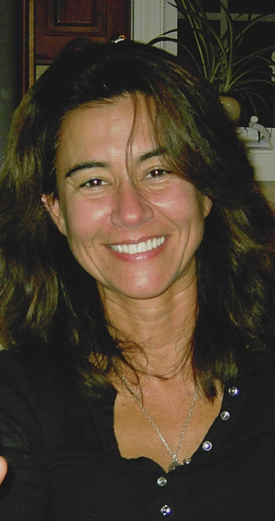
Anamarija Frankic, Biomimicry Institute Fellow and Director of the Green Harbors Project at the University of Massachusetts, Boston. (Photo by Anamarija Frankic).
FRANKIC: Biomimicry really utilizes biological models to evolve sustainable solutions to environmental, technological, engineering and design challenges that we have. And to not only learn from nature, but also learn about nature and its complexity to address our problems today. It’s almost like a common sense.
CURWOOD: Give me an example of biomimicry.
FRANKIC: When we are now building anything in our everyday life, we use glues to combine different structures. Most of those glues are based on formaldehyde, which is very poisonous. So, we are now using the same structures that we learned from shellfish that are using glues – organic glues – that are harder than any glues humans are able to create.
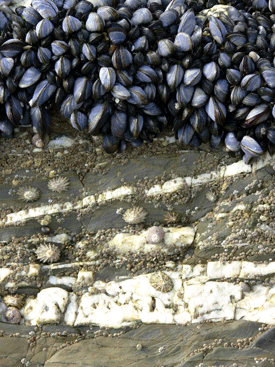
Blue mussels attach themselves to rocks in harsh conditions using only natural adhesives. Photo by John Davey, Courtesy of The Biomimicry Institute.
CURWOOD: Ah, what’s the secret to those organic glues? I know trying to get barnacles off the bottom of a boat is really an ordeal!
FRANKIC: Yes, and when you want to collect shellfish and specifically oysters, you need to use very hard hammer to detach them. When we talk about this organic glue, we are trying to use chemicals that are soluble in waters, that are not harmful to nature, because that’s the key principle, that nature produces chemicals that are not harmful to itself or to the next generation.
CURWOOD: Now, how can you use biomimicry to address questions of storm surges – what we saw around superstorm Sandy in the New Jersey/New York area, reminds us that our natural barriers to protect against storm surges are gone!
FRANKIC: That’s a question that, in the last 10 years, biomimicry has been working with designers and architects and landscape architects, to create what we call soft structures, so living structures along our hard structured harbors. Because, what we created in our urban harbors is like a very firm line between the water and the living coastal areas in our built harbors.
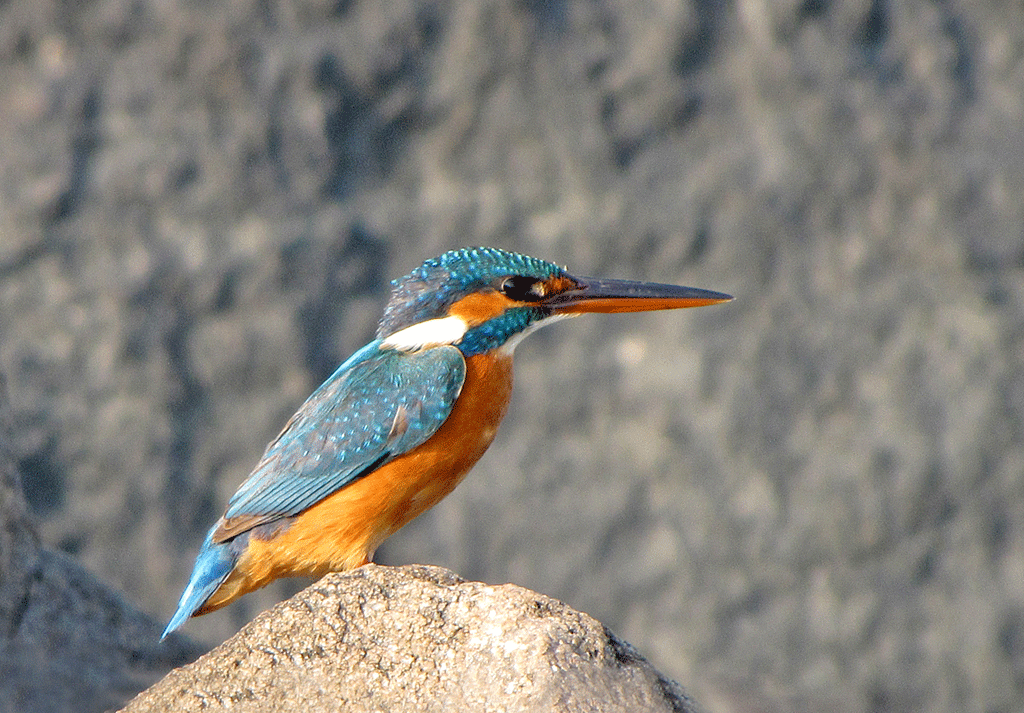
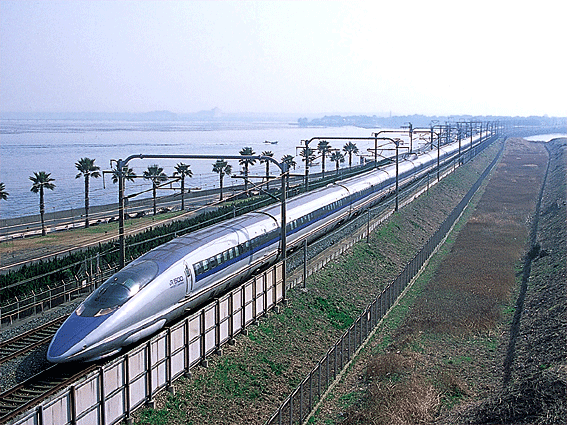
The kingfisher beak is so aerodynamic, the bird can dive for fish without making waves. The Shinkansen Bullet Train is influenced by the kingfisher’s beak. (Photos by BakaOnigiri, Wikimedia & by Flickr photographer wildxplorer, Courtesy of The Biomimicry Institute.)
And very often those lines are very concrete and straight. I always tell my students: If you find a straight line in the nature, call me, because everything has a reason how it formed, and designed and created the strategies that will, in a very long time, over millions of years, support their function in becoming more resilient and sustainable.
And how can we now build our structures that can biomimic the type of salt marshes and sea grass beds and eel grass beds, and that could maybe also in the biomimicry understanding – how could we also build structures in the long run that can support us and also be more adaptable for the environmental changes that we are constantly experiencing more and more so.
CURWOOD: Anamarija Frankic is a Biomimicry Institute fellow and Director of the Green Harbors project that the University of Massachusetts in Boston. Thank you so much!
FRANKIC: Thank you very much for having me!
Related links:
- Anamarija Frankic’s profile for the University of Massachusetts, Boston
- The Green Harbor’s Project
- Ask Nature is a webpage showcasing innovative biomimicry designs
Mimicking a Beetle to Bring Water to the People

The Namib Desert beetle (stenocara gracilipes) (Photo: Moongateclimber/Wikipedia Commons)
CURWOOD: Well, the lessons of nature have paid off in some remarkable products already – think airplanes, or Velcro, for example. And a unique water harvesting beetle inspired one of Professor Frankic's former students, Deckard Sorensen, to start a business.
SORENSEN: This beetle, the Namib desert beetle, lives in an area of the world that only gets half an inch of rainfall per year. However, every morning this beetle climbs to the top of a sand dune, sticks its back to the wind, and drinks 12 percent of its weight in water. So, we use nanotechnology to mimic this beetle’s back so that we too can pull water from the air.
CURWOOD: Tell me, what exactly are the physics here, how does it get water out of the air?
SORENSEN: It has super-hydrophobic and super-hydrophilic regions of water on its back. And micro droplets condense on these super hydrophilic regions, or water-loving regions, these micro droplets outgrow the ridge, and hit the water-hating region and aggregate all of the other droplets downwards.
CURWOOD: So, what did you take about what you learned from the Namib beetle and turn it into a business?
SORENSEN: We realized that if we can use air as a primary source of water, and realize that there are 3.9 quadrillion gallons of water in the earth’s atmosphere and that we can somehow have a way to tap into one of the largest reservoirs of water, and that being the air.
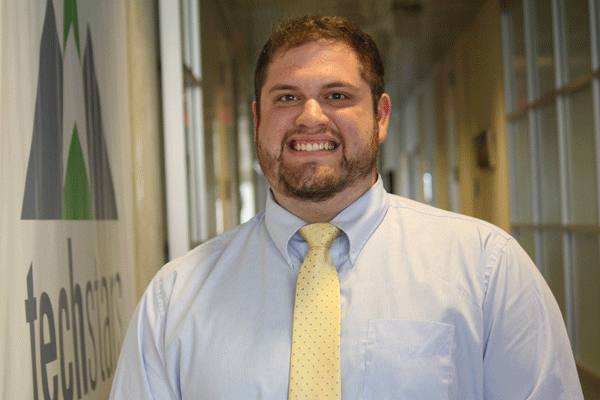
Deckard Sorenson is co-founder of NBD Nano. (NBD Nano)
CURWOOD: Tell me exactly what you do here - I understand that you have nanotechnology involved.
SORENSEN: Basically we apply this in a surface coating and use a fan to pass the air from the environment through, expose this air and clean this air, and pass it over our surface coatings, and the moisture that is in the air is extracted.
CURWOOD: So, you’d have a self-filling water bottle, then, huh?
SORENSEN: Ah, yes, that’s our end goal. To create a re-usable water bottle that fills itself. And we see this being applicable to anything from marathon runners to people in third world countries, because we realize that water is such a large issue in the world today, and we want to try to alleviate those problems with a cost efficient solution.
CURWOOD: Now, what about plants that would need more water than is available, how might this system work for them?
SORENSEN: We’re actually investigating a type of device that can be used for drip irrigation. And we are looking to incorporate this in greenhouses or green roofs in the immediate future, and then later on, we’re looking to see how far we can really scale this up to supply maybe farms or larger agricultural goals.
CURWOOD: So, how much energy is required to keep this system going? You say you have to blow the air over your special nanomaterial.
SORENSEN: It’s very low energy. I can’t give you a direct number right now but it’s low enough though that we’ve run all of our tests off solar panels and by use of a rechargeable battery.
CURWOOD: What’s fascinating about your technology, is that the energy comes from moving the air, so something moving like a car or a sailboat might be able to extract water with no really additional energy costs.
SORENSEN: Yup. We actually see the maritime environment as really a very large market for us because humidity is actually constantly regenerated over a large body of water and then we can pull that humidity from the air to support people who possibly take long trips on yachts, or provide a sort of potable water source that can be run off a solar panel while at sea.
CURWOOD: So, how much water can you make using this technology?
SORENSEN: The metric of our surface coating is about three liters per square meter per hour, and that is based off 70 degrees Fahrenheit and 75 percent relative humidity.
CURWOOD: So, what’s your running time for getting your beetle-inspired water systems up and running? When can I get a self-filling water bottle?
SORENSEN: We are raising our seed round of financing right now, and we expect to be in the market sometime mid-2014.
CURWOOD: Deckard Sorensen is a recent graduate of Boston College, and co-founder of NBD Nano. Thank you so much, Deckard!
SORENSEN: Thank you for having me.
Related link:
NBD Nano
BirdNote ®: Douglas Squirrel
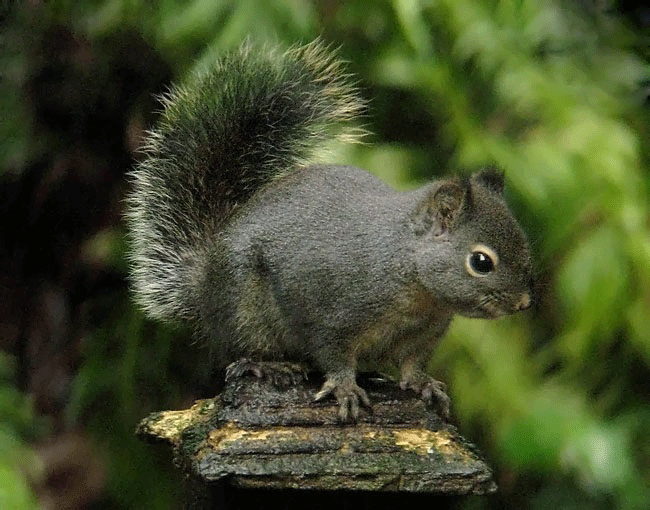
(Photo: © Mike Hamilton)
[BIRDNOTE® THEME]
CURWOOD: Yes - that's the music we play when we talk about birds in BirdNote®. Today though, we have another example of mimicry creeping into our BirdNote®, as Mary McCann explains.
[CALL OF A DOUGLAS SQUIRREL]
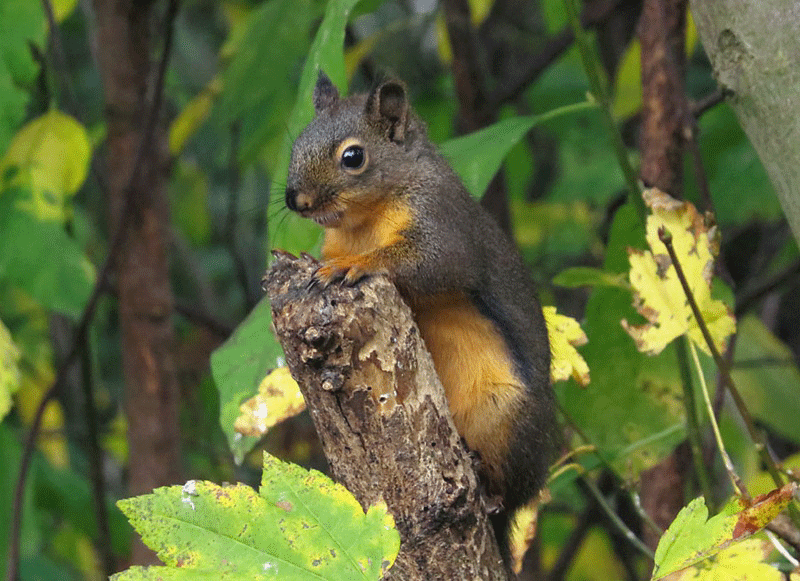
A Douglas Squirrel perched on a tree branch (Photo: © Mike Hamilton)
MCCANN: Doesn’t that sound like a bird? Actually, we’re hearing a Douglas squirrel, a pint-sized, chestnut-red native of forests from the Sierra Nevadas of California northward to coastal British Columbia and Southeast Alaska.
[CALL OF A DOUGLAS SQUIRREL]
MCCANN: They waste no time in telling you—and other squirrels—you’re in their territory, particularly if you’re near their central larder of conifer cones. Here’s a pair discussing our presence right now.

(Photo: © Mike Hamilton)
[DUET OF DOUGLAS SQUIRRELS SENDING ALARMS]
MCCANN: The Scottish explorer and botanist, David Douglas, surely heard them in 1825 when he traveled up the Columbia River with trappers for the Hudson’s Bay Company. He came to gather specimens of Pacific Northwest plants, including seeds of the large evergreen tree that today also bears his name.
[TRILL OF THE DOUGLAS SQUIRREL]
MCCANN: If you’re lucky, in summer, you’ll hear young squirrels racing up and down the tree trunks. Listen! You can hear their claws as they scamper on their vertical playground.
[YOUNG DOUGLAS SQUIRRELS RACING UP AND DOWN TREES]
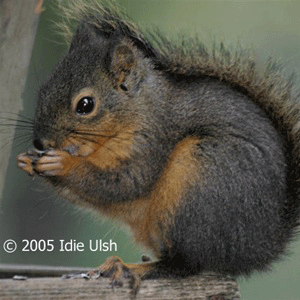
(© Idie Ulsh)
MCCANN: In fall, you might hear the sound of cones rocketing out of those trees, as Douglas squirrels gather them for winter. And what about those large, mostly silent squirrels that we see just about everywhere? Those are eastern gray squirrels, interlopers, when in the land of the Douglas.
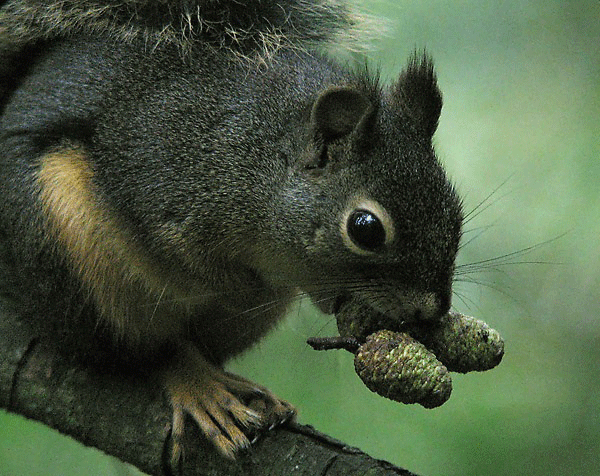
(Photo: © Mike Hamilton)
[ALARM CALL OF DOUGLAS SQUIRREL]
MCCANN: I’m Mary McCann.
CURWOOD: Check out the pictures of Douglas Squirrels at our web-site, loe dot org.
[Sounds of the Douglas squirrel recorded by C. Peterson
Written by Chris Peterson
Producer: John Kessler
Executive Producer: Chris Peterson
© 2012 Tune In to Nature.org November 2012 Narrator: Mary McCann}
Related link:
BirdNote ®
[MUSIC: Cornell Dupree “Squirrel” from I’m Alright (P-Vine Records 2011).]
CURWOOD: Living on Earth is produced by the World Media Foundation. Bobby Bascomb, Emmett Fitzgerald , Helen Palmer, Annie Sneed, James Curwood, Meghan Miner, and Gabriela Romanow all help to make our show. Jeff Turton is our technical director. Alison Lirish Dean composed our themes. You can find us anytime at L-O-E dot org - and check out our Facebook page - it’s PRI’s Living on Earth. I'm Steve Curwood.
Thanks for listening!
ANNOUNCER: Funding for Living on Earth comes from Stonyfield Farm, makers of organic yogurt, smoothies, and more. Stonyfield invites you to just eat organic for a day. Details at just eat organic dot com. Support also comes from you, our listeners. The Go Forward Fund and Pax World Mutual and Exchange Traded Funds. Integrating environmental, social, and governance factors into investment analysis and decision making. On the web at Pax World dot com. Pax World, for tomorrow.
ANNOUNCER 2: PRI Public Radio International
Living on Earth wants to hear from you!
Living on Earth
62 Calef Highway, Suite 212
Lee, NH 03861
Telephone: 617-287-4121
E-mail: comments@loe.org
Newsletter [Click here]
Donate to Living on Earth!
Living on Earth is an independent media program and relies entirely on contributions from listeners and institutions supporting public service. Please donate now to preserve an independent environmental voice.
NewsletterLiving on Earth offers a weekly delivery of the show's rundown to your mailbox. Sign up for our newsletter today!
 Sailors For The Sea: Be the change you want to sea.
Sailors For The Sea: Be the change you want to sea.
 The Grantham Foundation for the Protection of the Environment: Committed to protecting and improving the health of the global environment.
The Grantham Foundation for the Protection of the Environment: Committed to protecting and improving the health of the global environment.
 Contribute to Living on Earth and receive, as our gift to you, an archival print of one of Mark Seth Lender's extraordinary wildlife photographs. Follow the link to see Mark's current collection of photographs.
Contribute to Living on Earth and receive, as our gift to you, an archival print of one of Mark Seth Lender's extraordinary wildlife photographs. Follow the link to see Mark's current collection of photographs.
 Buy a signed copy of Mark Seth Lender's book Smeagull the Seagull & support Living on Earth
Buy a signed copy of Mark Seth Lender's book Smeagull the Seagull & support Living on Earth

